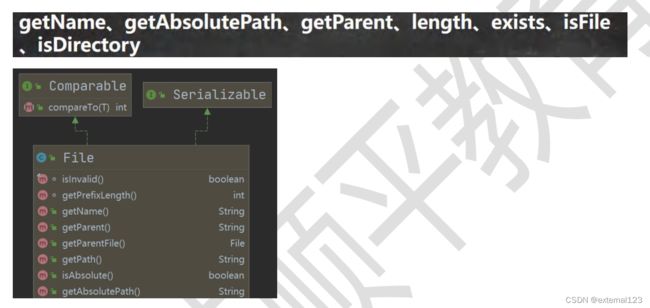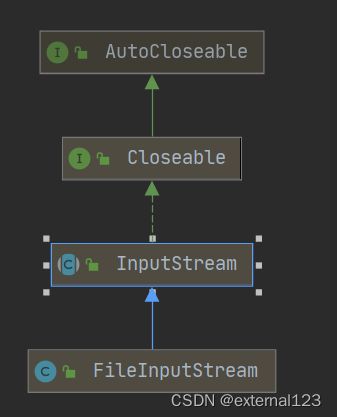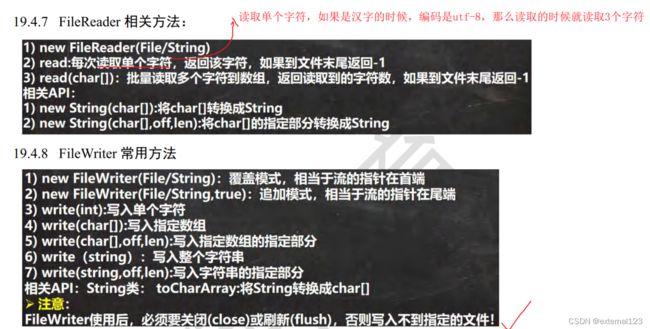文件与IO流基础接收(全面)
文件与IO流
文章目录
- 文件与IO流
-
-
- 1. 文件
- 2. 常用的文件操作
- 3. 常用的流操作
-
- 3.1 流的分类
- 3.2 FileInputStream 介绍
- 3.3 FileOutputStream的介绍
- 3.4 FileReader 与 FileWriter
- 3.5 处理流 BufferReader和BufferWriter介绍
- 3.6 处理流 BufferedOutputStream 和 BufferedInputStream
-
1. 文件
- 定义:文件是保存数据的地方
- 文件流:流,顾名思义,是一个流动的东西,也可以说是一个路径。表达的是从文件到程序(内存)之间的路径,输入与输出(In or Out)是相对于程序来说的。
2.1 输入流:从文件(外存)到程序(内存)之间的路径
2.2 输出流:从程序(内存)到文件(外存)之间的路径

2. 常用的文件操作
- File的构造
1.1 根据路径构造一个File文件。new File(String pathname)
1.2 根据父目录文件+子路径构造。new File(File parent, String Child)
1.3 根据父目录+子路径构造。new File(String parent, String Child)
1.4 注意:new File(…)的时候并没有真正的创建文件,只有执行了createFile方法的时候,才在磁盘创建了该文件。
给出一个例子:
//方式2 new File(File parent,String child) //根据父目录文件+子路径构建
//e:\\news2.txt
@Test
public void create02() {
File parentFile = new File("e:\\");
String fileName = "news2.txt";
//这里的file对象,在java程序中,只是一个对象
//只有执行了createNewFile 方法,才会真正的,在磁盘创建该文件
File file = new File(parentFile, fileName);
try {
file.createNewFile();
System.out.println("创建成功~");
} catch (IOException e) {
e.printStackTrace();
}
}
- 获取文件相关信息
这里就是简单的方法调用,File对象是调用的主体。

- 目录操作
3.1 目录也是一种特殊的文件,可以使用exists方法来判断是否存在
3.2 创建目录有两个方法,分别是创建创建一级目录的:mkdir();创建多级目录的:mkdirs()。
下面给出一个示例:
//判断 D:\\demo\\a\\b\\c 目录是否存在,如果存在就提示已经存在,否则就创建
@Test
public void m3() {
String directoryPath = "D:\\demo\\a\\b\\c";
File file = new File(directoryPath);
if (file.exists()) {
System.out.println(directoryPath + "存在..");
} else {
if (file.mkdirs()) { //创建一级目录使用mkdir() ,创建多级目录使用mkdirs()
System.out.println(directoryPath + "创建成功..");
} else {
System.out.println(directoryPath + "创建失败...");
}
}
3. 常用的流操作
- I/O技术是Input/Output的缩写,是非常使用的技术,用于数据处理,读写文件,网络通讯等等。
- 数据的输入/输出操作以“流(stream)”的方式进行。
- java.io包中,提供了各种“流”的类和接口,用于获取不同的种类的数据,通过方法输入或者输出数据。
3.1 流的分类
- 根据数据方向的不同:输入流 与 输出流
- 根据读取/写入的单位的不同:字节流 与 字符流
- 根据功能的不同:节点流 与 处理流
- 四个抽象基类,派生出40多个类,派生出的子类的名称以其父类名作为子类名后缀。


3.2 FileInputStream 介绍
FileInputStream的继承关系:

既然是从文件中按照字节的方式读取到内存中的类,那么这个类中最重要的方法一定是read,下面给出一个使用字节数组读取数据的示例
/**
* 使用 read(byte[] b) 读取文件,提高效率
*/
@Test
public void readFile02() {
String filePath = "e:\\hello.txt";
//字节数组
byte[] buf = new byte[8]; //一次读取8个字节.
int readLen = 0;
FileInputStream fileInputStream = null;
try {
//创建 FileInputStream 对象,用于读取 文件
fileInputStream = new FileInputStream(filePath);
//从该输入流读取最多b.length字节的数据到字节数组。 此方法将阻塞,直到某些输入可用。
//如果返回-1 , 表示读取完毕
//如果读取正常, 返回实际读取的字节数
while ((readLen = fileInputStream.read(buf)) != -1) {
System.out.print(new String(buf, 0, readLen));//显示
}
} catch (IOException e) {
e.printStackTrace();
} finally {
//关闭文件流,释放资源.
try {
fileInputStream.close();
} catch (IOException e) {
e.printStackTrace();
}
}
}
3.3 FileOutputStream的介绍
继承关系:

既然是从内存向文件输出信息,那么最重要的方法是write()。给出使用的示例:
@Test
public void writeFile() {
//创建 FileOutputStream对象
String filePath = "e:\\a.txt";
FileOutputStream fileOutputStream = null;
try {
//得到 FileOutputStream对象 对象
//老师说明
//1. new FileOutputStream(filePath) 创建方式,当写入内容是,会覆盖原来的内容
//2. new FileOutputStream(filePath, true) 创建方式,当写入内容是,是追加到文件后面
fileOutputStream = new FileOutputStream(filePath, true);
//写入一个字节
//fileOutputStream.write('H');//
//写入字符串
String str = "hsp,world!";
//str.getBytes() 可以把 字符串-> 字节数组
//fileOutputStream.write(str.getBytes());
/*
write(byte[] b, int off, int len) 将 len字节从位于偏移量 off的指定字节数组写入此文件输出流
*/
fileOutputStream.write(str.getBytes(), 0, 3);
} catch (IOException e) {
e.printStackTrace();
} finally {
try {
fileOutputStream.close();
} catch (IOException e) {
e.printStackTrace();
}
}
}
3.4 FileReader 与 FileWriter
- 3.2 与 3.3 介绍的两个类,是按照字节读取文件适用于视频或者音频等。
而现在介绍的这两个类使用字符来读取文件,适用于文本文件,不适用于二进制文件,如果用他们来读取二进制文件会出现乱码。 - 下面介绍一下两者的不同
/**
* 字符数组读取文件
*/
@Test
public void readFile02() {
System.out.println("~~~readFile02 ~~~");
String filePath = "e:\\story.txt";
FileReader fileReader = null;
int readLen = 0;
char[] buf = new char[8];
//1. 创建FileReader对象
try {
fileReader = new FileReader(filePath);
//循环读取 使用read(buf), 返回的是实际读取到的字符数
//如果返回-1, 说明到文件结束
while ((readLen = fileReader.read(buf)) != -1) {
System.out.print(new String(buf, 0, readLen));
}
} catch (IOException e) {
e.printStackTrace();
} finally {
try {
if (fileReader != null) {
fileReader.close();
}
} catch (IOException e) {
e.printStackTrace();
}
}
}
public class FileWriter_ {
public static void main(String[] args) {
String filePath = "e:\\note.txt";
//创建FileWriter对象
FileWriter fileWriter = null;
char[] chars = {'a', 'b', 'c'};
try {
fileWriter = new FileWriter(filePath);//默认是覆盖写入
// 3) write(int):写入单个字符
fileWriter.write('H');
// 4) write(char[]):写入指定数组
fileWriter.write(chars);
// 5) write(char[],off,len):写入指定数组的指定部分
fileWriter.write("韩顺平教育".toCharArray(), 0, 3);
// 6) write(string):写入整个字符串
fileWriter.write(" 你好北京~");
fileWriter.write("风雨之后,定见彩虹");
// 7) write(string,off,len):写入字符串的指定部分
fileWriter.write("上海天津", 0, 2);
//在数据量大的情况下,可以使用循环操作.
} catch (IOException e) {
e.printStackTrace();
} finally {
try {
//fileWriter.flush();
//关闭文件流,等价 flush() + 关闭
fileWriter.close();
} catch (IOException e) {
e.printStackTrace();
}
}
System.out.println("程序结束...");
}
}
3.5 处理流 BufferReader和BufferWriter介绍


让我们来看看BufferReader和BuffWriter的源代码


也就是说,BuffReader中封装了一个reader和一个字符数组,这样的话提高了读的效率
下面给出一个例子
public class BufferedReader_ {
public static void main(String[] args) throws Exception {
String filePath = "e:\\a.java";
//创建bufferedReader
BufferedReader bufferedReader = new BufferedReader(new FileReader(filePath));
//读取
String line; //按行读取, 效率高
//说明
//1. bufferedReader.readLine() 是按行读取文件
//2. 当返回null 时,表示文件读取完毕
while ((line = bufferedReader.readLine()) != null) {
System.out.println(line);
}
bufferedReader.close();
}
}
public static void main(String[] args) throws IOException {
String filePath = "e:\\ok.txt";
//创建BufferedWriter
//说明:
//1. new FileWriter(filePath, true) 表示以追加的方式写入
//2. new FileWriter(filePath) , 表示以覆盖的方式写入
BufferedWriter bufferedWriter = new BufferedWriter(new FileWriter(filePath));
bufferedWriter.write("hello, 韩顺平教育!");
bufferedWriter.newLine();//插入一个和系统相关的换行
bufferedWriter.write("hello2, 韩顺平教育!");
bufferedWriter.newLine();
bufferedWriter.write("hello3, 韩顺平教育!");
bufferedWriter.newLine();
//说明:关闭外层流即可 , 传入的 new FileWriter(filePath) ,会在底层关闭
bufferedWriter.close();
}
}
3.6 处理流 BufferedOutputStream 和 BufferedInputStream
与3.5类似,这两分别是OutputStream和InputStream的包装流
给出示例
public class BufferedCopy02 {
public static void main(String[] args) {
// String srcFilePath = "e:\\Koala.jpg";
// String destFilePath = "e:\\hsp.jpg";
// String srcFilePath = "e:\\0245_韩顺平零基础学Java_引出this.avi";
// String destFilePath = "e:\\hsp.avi";
String srcFilePath = "e:\\a.java";
String destFilePath = "e:\\a3.java";
//创建BufferedOutputStream对象BufferedInputStream对象
BufferedInputStream bis = null;
BufferedOutputStream bos = null;
try {
//因为 FileInputStream 是 InputStream 子类
bis = new BufferedInputStream(new FileInputStream(srcFilePath));
bos = new BufferedOutputStream(new FileOutputStream(destFilePath));
//循环的读取文件,并写入到 destFilePath
byte[] buff = new byte[1024];
int readLen = 0;
//当返回 -1 时,就表示文件读取完毕
while ((readLen = bis.read(buff)) != -1) {
bos.write(buff, 0, readLen);
}
System.out.println("文件拷贝完毕~~~");
} catch (IOException e) {
e.printStackTrace();
} finally {
//关闭流 , 关闭外层的处理流即可,底层会去关闭节点流
try {
if(bis != null) {
bis.close();
}
if(bos != null) {
bos.close();
}
} catch (IOException e) {
e.printStackTrace();
}
}
}
}
以上内容来自 韩顺平学java
